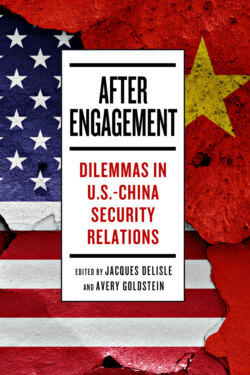Читать книгу After Engagement - Группа авторов - Страница 17
На сайте Литреса книга снята с продажи.
TWO Assessing the Dangers of Conflict The Sources and Consequences of Deepening US-China Competition CHARLES L. GLASER
ОглавлениеOver the past decade, US-China relations have become more competitive in the military, economic, and geopolitical realms. The 2017 US National Security Strategy (NSS) states “China seeks to displace the United States in the Indo-Pacific region, expand the reaches of its state-driven economic model, and reorder the region in its favor.… For decades, U.S. policy was rooted in the belief that support for China’s rise and for its integration into the post-war international order would liberalize China. Contrary to our hopes, China expanded its power at the expense of the sovereignty of others.”1 This chapter explores why this shift in US-China relations has occurred, whether the trend is likely to continue during the Biden administration, the implications for war between the United States and China, and guidance for US policy.2
This chapter presents four basic arguments. First, the increasingly competitive relationship largely reflects the combination of China’s increasing power and a significant geopolitical disagreement over Taiwan. China considers Taiwan to be a core interest, and US commitments and military capabilities challenge China’s ability to adequately protect this interest. When China began its conventional buildup over two decades ago, the United States dominated the Strait of Taiwan. Thus, given China’s growing economy, the natural move by China was to invest in the military capabilities required to better protect this vital interest. The United States sees the Chinese buildup as undermining the capabilities it requires to meet its commitment to Taiwan and, therefore, is responding to offset it, partly explaining the so-called rebalance to Asia and US development of AirSea Battle3 to defeat Chinese conventional modernization. Although sometimes described in terms of the security dilemma, the competition reflects a more fundamental disagreement about Taiwan; the problem is not created by the anarchic structure of US-China interactions and cannot be eliminated by confidence that neither country will use its forces to attack.
In addition, the two countries may disagree over a second major geopolitical issue—the future of US security alliances in Northeast Asia. Official US strategy documents and many US experts believe China is determined to push the United States out of East Asia. This is entirely incompatible with US grand strategy, which identifies US alliances in Asia as one of its central pillars. It is important to note, however, that many experts on Chinese foreign policy believe China is not determined to become the East Asian hegemon. But if they are wrong and China has decided to give priority to ending the US military presence in Northeast Asia, then the two countries have a second major conflict of interest, which will fuel intensifying military competition. A key question, then, is whether this conflict of interest reflects China’s need to maintain a coercive capability against Taiwan, which would be greatly facilitated by US withdrawal from East Asia, or reflects a more fundamental interest in regional hegemony that reflects ideational rationales, including nationalism and great power status.
Second, and somewhat in tension with the first, the shift to more adversarial relations has been driven most prominently by contestation over lesser issues, not Taiwan and China’s possible drive for regional hegemony. China’s more assertive behavior in the South China Sea and the East China Sea—including challenges to Japan’s administrative control of the Senkaku/Diaoyu Islands, its island-building and construction of military facilities in the South China Sea, and its rejection of the judgment by an international tribunal against its claims in the South China Sea—has generated much of the negative reassessment of China’s goals. The adversarial nature of the relationship has been further fueled by China’s unfair trade practices, the possibility that its high technology exports create security vulnerabilities, and its cyber hacking. During the Trump years, tensions were additionally deepened by China’s internment of Uighurs in Xinjiang, the US-initiated trade war, China’s imposition on Hong Kong of a new national security law, and mutual recriminations over the countries’ responses to the coronavirus. While these all are important issues, judged in material and strategic terms, Taiwan and China’s possible pursuit of regional hegemony dwarf them.
Third, the greatest danger posed by the contestation of these lesser interests is not that a crisis over one of them will escalate to full-scale war but, instead, that the ongoing disputes will further strain US-China relations in ways that make war over Taiwan more likely. Because the stakes are limited, the United States and China should have reasonably good prospects for avoiding undesired escalation, even though there will be some military pressures for escalation. The more likely paths to major war are those that start initially and intentionally over Taiwan. Contestation of these secondary issues could influence the probability of war over Taiwan by leading the United States and China to adopt increasingly hostile views of each other, and, in turn, to embrace more assertive or unbending policies toward Taiwan. This dynamic appears to have begun during the Trump administration.
Fourth, because China is motived at least partly by security concerns, US policy needs to consider the benefits of cooperation and possible changes to the status quo, as well as the benefits of more competitive policies and how to combine the two approaches. Many experts have concluded that because China’s ambitions are large, the United States should adopt highly competitive policies. This conclusion, however, fails to adequately consider the sources of China’s ambitions and, therefore, risks providing flawed guidance.
This chapter first lays the foundation for analyzing China’s more assertive policies by briefly describing the key areas and issues over which competition has occurred. The second section explores the underlying interests that fuel this competition. The third section offers explanations for the competition. The final section considers the implications for the future trajectory of US-China relations and military competition, and related US policy.
